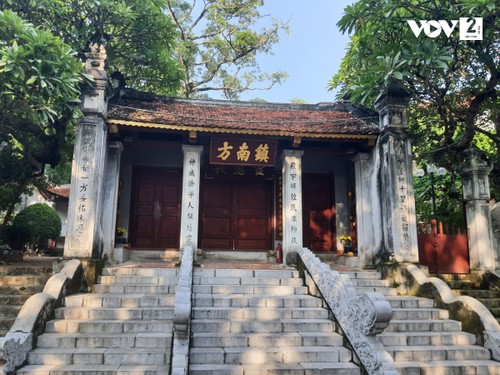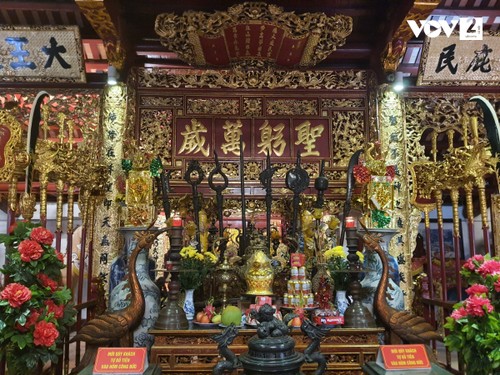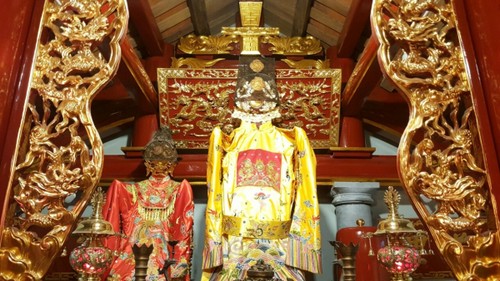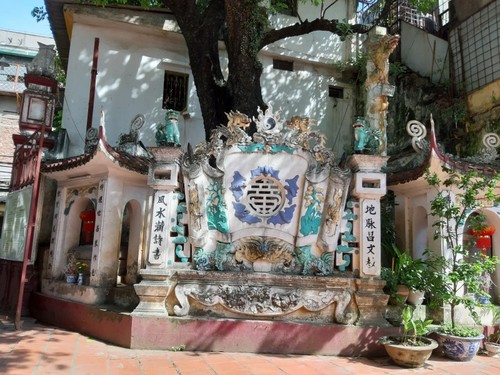Kim Lien Temple (also called Cao Son Temple) is one of four sacred temples in Hanoi. The temple was built to guard the southern entrance of Thang Long Citadel. Three other temples, which guarded three other entrances, are Quan Thanh, Bach Ma, and Voi Phuc Temple.
Kim Lien Temple with its elaborate decorative motifs has been faithfully preserved.
 The main entrance of Kim Lien Temple. The main entrance of Kim Lien Temple. |
Mr. Pham Gia Ngoc, a cultural cadre in Dong Da district, said that Kim Lien Temple was built before the 11th century. It is dedicated to Cao Son Dai Vuong - a deity who watches over farm work and protects people from natural disasters.
The temple was just a small temple at first, but in the 16th century, in the reign of King Le Tuong Duc, it was rebuilt and expanded, according to Mr. Ngoc.
“Kim Lien Temple sits on a hill, looking toward the south. According to cultural researchers, a southern orientation symbolizes intelligence, enlightenment, and new beginnings,” said Ngoc.
Kim Lien Temple was built on a hillock east of the Kim Lien lagoon. Both gates of the temple and the main worshiping hall all overlook the lagoon, according to Ngoc.
“Passing through the temple’s gate, you take a long stroll through a courtyard before entering the “nghi mon” or main entrance. The nghi mon is a three-compartment chamber with lively decorative details, such as phoenixes holding books in their beaks, clouds, and a unicorn. Continuing through the ‘nghi mon’, you come to the ‘dai bai’ - the worshiping hall - which is a five-compartment chamber,” said Ngoc.
The last part of Kim Lien Temple - the Forbidden Chamber - was the residence of Cao Son Dai Vuong and his two wives, Princess ‘Thuy Tinh de tam’ (the third daughter of King Le) and Mrs. Hue Minh.
 The Forbidden Chamber of Kim Lien Temple. The Forbidden Chamber of Kim Lien Temple. |
Kim Lien Temple contains many historical relics, according to Mr. Nguyen Quoc Hung, head of the relic management board:.
“Kim Lien Temple has great historical importance as it conserves 39 imperial edicts of the Le and Nguyen dynasties conferred to God Cao Son. 33 of the imperial edicts have been recognized as precious treasures by the Vietnamese National Archives,” said Hung.
The most important relic at Kim Lien Temple is a stone epitaph erected in 1510. It is 2.3 meters high, 1.5 meters wide and 0.22 meters thick, and memorializes Cao Son’s helping King Le to regain his throne. A small pavilion was built later to shelter this ancient stele.
Since 2000, Kim Lien Temple has undergone repeated renovations and repair, but much of its original architecture is still intact.
“The temple’s structure has been renovated, but some parts, like the roofs, were kept the same. You can hardly notice the changes. It still looks like the original temple,” said Nguyen Kim Binh, a local resident.
The Kim Lien Temple festival commemorating God Cao Son used to last four days, from March 13 to March 16 of the lunar calendar. Lately the event has been shortened to just two days - March 15 and 16.
One of the four original guardians of the Thang Long Citadel, Kim Lien Temple now guards its own rich historical heritage.
Another iconic religious site in Phuong Lien ward is Trung Tu communal house, which is closely attached to the history of ancient Trung Tu village.
Trung Tu village was located in Dong Tac, one of 36 guilds of ancient Thang Long (now Hanoi) under Le dynasty in the 15th century. Trung Tu communal house is an ancient architectural structure that has witnessed historical ups and downs in the village over the years. The communal house was built in the late 17th century. At first, it was a small temple to worship God Cao Son and Hue Minh princess, then it was expanded into a communal house.
 Trung Tu communal house worships Cao Son Dai Vuong and Princess Hue Minh. Trung Tu communal house worships Cao Son Dai Vuong and Princess Hue Minh. |
Trung Tu communal house was renovated several times, with the latest renovation in 2020, according to Mr. Nguyen Van Tan, Head of its management board.
“During the renovation, we rebuilt the communal house on the foundation of the original one. The structure and architecture of the communal house are still kept intact,” said Tan.
The rebuilt Trung Tu communal house has gigantic architecture. It has 5 compartments, 3 of which serve as harems and 1 pavilion connecting the roof. In the main hall, there is a set of dragon thrones in 16th century Mac Dynasty style with two dragon heads facing in.
The second compartment has a set of 4 main doors decorated with ancient horizontal lacquered board engraved with Chinese characters.
In the middle, there is a large throne worshipping the village’s God. The throne has two arms carved with delicate dragons, the back is decorated with the image of a flying dragon. The four corners are carved in the shape of carp heads.
On the left side of the fourth compartment, there is also an altar, on top of it is a gilded wooden bench with 6 pillars shaped like dragons.
Nguyen Quyet Thang, an elder of Phuong Lien ward, said all the parallel sentences and pairs of wood panels from different dynasties remain intact in Trung Tu communal house.
“According to historians and researchers, the architecture and parallel sentences date back from the later Le Dynasty or Le Trung Hung Dynasty which existed 256 years from the 16th to 18th century. Trung Tu communal house is a sacred and peaceful place,” said Thang.
 An altar at the entrance of Trung Tu communal house. An altar at the entrance of Trung Tu communal house. |
Trung Tu communal house festival is held every year on the 15th of March of the lunar calendar to show villagers’ gratitude to their tutelary god.
Pham Gia Ngoc, a cultural cadre in Phuong Lien ward, said the Trung Tu festival is a good example of the tradition “Drink water, remember the source”.
“People near and far gather at the Trung Tu communal house festival. On this day, villagers offer feasts according to each family clan. The village festival procession is the highlight of the festival and takes place every 3 year. Villagers prepare for the procession several months prior to the event. They prepare food trays, and worshipping offerings. The festival is of great significance in the spiritual life and belief of local people,” said Ngoc.
Trung Tu communal house embodies rich historical relics and values. During the resistance war against French colonialism, the communal house was used as a shelter for revolutionary cadres.
Over the years, Trung Tu communal house has stood the test of time with historical, cultural, and architectural values remaining intact and serving as an important relic site in the capital city of Hanoi.